
By Sebastián Bianchi
The shields covered in this section may be divided into four subcategories; officially instituted but never produced shields, unofficially produced shields, prototypes, and fantasy shields. All of the pictures here are to be considered reproductions, as it would be nearly impossible to validate any of them.
Official Shields (never mass produced)
Warsaw Shield
The Warsaw shield was instituted on December 10th, 1944, and was to be presented to members of the Wehrmacht and auxiliary forces who participated in combating the rebellion in that city during August 1st and October 4th of that year. The troops, under the command of SS Obergruppenfuhrer unf General der Polizie Erich von dem Bach-Zelewiski ,battled the free Polish army and used brutal force in putting down the rebellion. Two SS divisions in particular, the 29th Ukrainian volunteers under Bratislav Kaminski and the 36th under Dr Oskar Dirlewanger, committed such appalling acts that a few of the worst offenders were executed for discreditable conduct. One can imagine the severity of the acts that compelled the Warsaw commander to take such drastic action at this late stage of the war. As it is often the case in battles involving partisan, however, atrocities went both ways. In this hard fought battle no quarrel was asked for or given on either side.
| The award consisted of a shield with a flat top and a pointed bottom.
The body of the shield was filled with a large eagle (representing the
German Forces) choking with its claws a snake with its mouth open
(representing the rebels). The eagle had a swastika and on its chest and a
marquee with the legend “WARSCHAU 1944” below this Nazi symbol. Criteria
for the shield were as follows;
To have participated on a minimum of seven combat days Luftwaffe, |
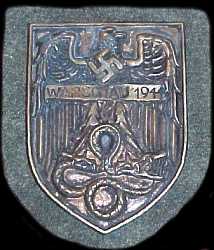 |
The shield was put into production but an allied air raid destroyed all
equipment and produced badges. Though of course it is plausible that some
survived they would be very difficult if not impossible to authenticate. None of
these badges were ever presented.
Lappland Shield
The Lapland Shield was the last officially instituted German battle shield of the war. This award, created in February of 1945, was to recognize the efforts of the 20th Mountain Army group commanded by General Boehme, who had been fighting a two front war against the English and the Russians since November 1944. The shield was officially approved on May 1st, 1945, a day after Hitler’s death. The Army surrendered to the British on May 8th, 1945.
Thought the shield was recorded into Soldbuchs as early as April, it is believed that no awards were actually presented at this time. However, after the cessation of hostilities the German forces in the area found that their captor, General Thorne, went against common practice and allowed his prisoners to wear their decorations (it is of interest to note that the reason for the liberal attitude of the British forces was that at that time the possibility of using German troops to stem the Soviet advance had not been discarded). In light of this circumstance, the men of 20th Army began to produce the shield from whatever industry was available in the area (it was constructed from a variety of medals including zinc, aluminum and tin).
| Presentation of the award then took place, with the commanding German
officer, General Boehme, in charge of this task. It has been stated that
the criteria for the shield included 6 months service in the area, to have
been wounded in an engagement in the area or to have attained a bravery
award in the area. Even though the award was presented after the end of
the war, it should be considered an official award as it was authorized
prior to the capitulation of the Wehrmacht.
The award itself consisted of a crudely constructed shield which had a rounded bottom and a flat top, with a rim running along the edge of it. Immediately below the top there was a horizontal bar with an eagle perched on it. The eagle in the shield does not include a swastika, as this of course would have been unacceptable to the Allied forces. Immediately beneath this is the word “LAPPLAND” and under it there was a map of the area. On the edges of it four small holes were perforated from which the shield was sown to the uniform. Needless to say, this award has countless variants and, being field produced, was of a very low quality. |
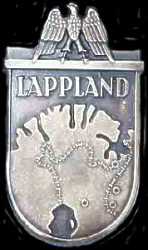 |
Unofficial Shields
Lorrient Shield
The Lorrient Submarine first , home to the 10th and 2nd U-boat Flotillas as well as the 14th Sub-Hunter Flotilla, first came into use in September 1942. It was eventually expanded to include three colossal submarine bunkers that included dry docks with cathedral ceilings, and was of vital importance to the German maritime war effort. In 1944, following the Normandy landings and drive inland, the base, along with other important ports, was surrounded and isolated. It was deemed necessary to deny the enemy access to the channel ports for the longest possible time, and many city-ports were ordered to resist. In this quest the Kriegsmarine was to help with all available sources, and when these where exhausted the arms and personnel use for ground defense. Though not all ports were successfully defended, the garrisons in La Rochelle, St Nazaire, Lorrient and Dunkirk held their ground until the end of the hostilities.
At Lorrient, approximately 26,000 men of all branches of the Wehrmacht were gathered under the command of General Fahembacher. Heavily fortified, the base counted on numerous buried bunkers and well built fortifications protecting the approach via land. The area was also heavily mined. For this reason the Allies simply bypassed the fortress after surrounding it but constantly harassed it by naval bombardments, air attacks, and land patrols. Despite these attacks and their desperate situation, the German garrison was able to fight on until the end of the war.
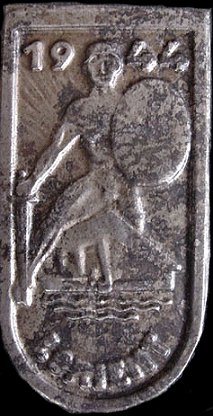
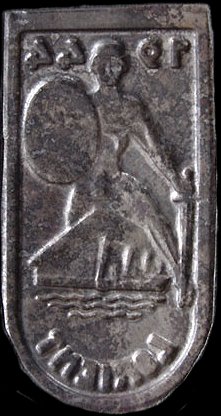
The circumstances and institution date of the shield are not exactly known, but it was toward the end of 1944 that General Fahembacher authorized the commemorative award (it was only locally authorized). The shield itself had a flat top and rounded bottom, with its main feature being a nude warrior wearing a German helmet, who held in his left hand an oval shield, and in his right hand a double-edge sword. The shield he holds is adorned with an eagle clutching a swastika. The warrior is standing on a u-boat pen with a u-boat coming out of it. Waves in three lines are below the u-boat pen. The shield was crudely constructed in the base from whatever materials were available, and enough were made for about half the garrison. It was sown to the uniform by way of four small holes drilled in the corners.
There exists another variant of this shield, which in fact is not a shield at all but a modified identity disk. Instead of the usual numbers, the disk contains the words “FESTUNG LORRIENT”. Small holes were drilled on either side enabling the shield to be sown to the uniform. It is thought that this was an improvisation to take the place of the official shield until one could be presented, a deed which of course never took place.
Dunkirk Shield
The port city of Dunkirk, made famous for the withdrawal operation of 1940, was again the center of fighting in 1944-45. After the allied landing, Dunkirk was surrounded but singled out by Hitler as one of the port cities that was to hold out for the longest possible time.
Dunkirk was under the command of Konteradmiral Frederich Frisius, who counted on a force of 15,000 men made up of the 226th Infantry Division and assorted personnel. Opposite them were men from the free Czech brigade, who had landed in Normandy in June 1944. Though totally surrounded, Konteradmiral Frisius launched a raiding operation codenamed “Blucher” on April 5th, 1945. It was only a small-scale attack but it took the Czech and British forces by complete surprise because of its ferocity. Counter-attacks to dislodge the German forces from their new positions were unsuccessful. As mentioned above, the forces were able to hold out until the end of the war.
| The shield was only locally authorized and had a flat top and rounded
bottom. Across the top in capital letters is the work “DUENKIRCHEN”. The
body of the shield was occupied by the watchtower of Dunkirk, with the
numbers “19” and “44” on either side on the top of the tower and waves in
three lines behind it toward the bottom. Across the bottom part of it,
there was a chain consisting of seven links.
Little is known about this shield, as very few were awarded, but examples of pay books with entries referencing it do exist. |
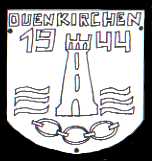 |
Balkan Shield
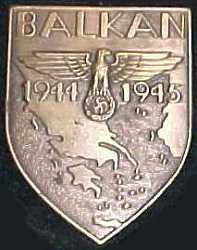 |
This shield was to be presented to the forces who were holding back
the Bolshevik attack on the Balkans (in addition to the red army, the
forces here had to content with constant partisan activity). The designed
was submitted to Hitler early in 1945 but was never mass-produced.
The award was designed by Benno von Arent, and consisted of a shield with a flat top and pointed bottom across the top portion of which was the work “BALKAN”. An eagle (of very poor quality) clutching a swastika, with the dates “1944” and “1945” on either side, was placed under this word and map of the Balkan area fills the rest of the badge. Whether or not the shield was ever presented is under debate though Mr. Aisby states in “Word War II German Medals” that SS Obersharfuhrer Fredrich Olesh (who formed part of the Prins Eugen division) told him that he personally awarded approximately 250 Balkans shields. |
Prototype Shields
Stalingrad Shield
| On October 2nd, 1942 Hitler ordered a shield to commemorate
the men of 6th Army then fighting in the city and a prototype created by
Ernst Eigener (an artist with Propaganda Company 637).
The shield had a pointed bottom with a closed wing eagle on the top. The main body had across the top the inscription “STALINGRAD”, with three silos that were a landmark of Stalingrad and had been the subject of bitter battles beneath the word. In front of the silos there was a dead German soldier with a crown of barbed wire around his helmet. The prototype was submitted to the High Command and understandably rejected as too morbid. Ernst Eigener, the designer of the badge, meet his fate at Stalingrad in November 1942. |
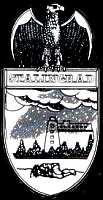 |
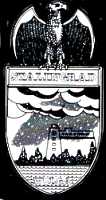 |
A second prototype was later submitted by Feldmarshall von Paulus. This design substituted the soldier for the silhouette of a river with the “WOLGA” beneath it. This shield was of course never instituted as the battle turned out to be a disaster, the Russians broke through Axis Allied lines (Italian and Bulgarian), encircled and eventually destroyed 6th Army. Feldmarshall von Paulus surrendered with on January 30th, taking with him 94,000 men into captivity. Of them, only 5,000 would ever return home. |
Fantasy Shields
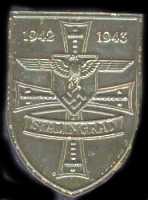 |
There have been other shields in circulation that claim to be prototype shields but are just contemporary fabrications. An example of this type of shield is pictured here. This Stalingrad Shield was produced in England in 1979 from rusted steel (giving it an "aged" look) and is a complete fabrication of the modern imagination. I have seen this shield recently in internet auctions. |
![]()
© Copyright Wehrmacht-Awards.com LLC |